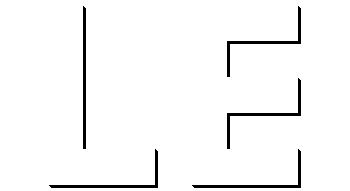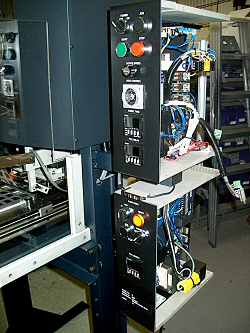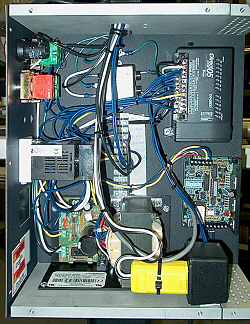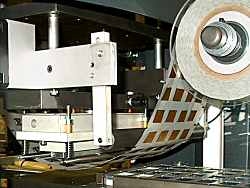LAUGHTON ELECTRONICS |
|
Foiled Again: a stepper and PLC deliver film media |
|
 |
In this project, a system I provided was merged with an already- existing design. The customer is a manufacturer of high quality hot foil stamping presses, and they were developing a new machine to add to their product line. |
|
 |
Hot foil stamping is used to add visual appeal to familiar items such as credit cards, retail boxes and Award Ribbons. It works by pressing an embossed, heated die against a pigmented foil and onto the target medium. The result is a shiny, metallic image unattainable by using ink. The foil is supplied in a continuous ribbon which needs to be advanced following each impression. My job was to set up a stepper motor system for advancing the foil. A key goal with this project was that the "pull," or draw length, would be set electronically. Compared to the crank- driven foil advance used on other machines, this would be much easier for the machine operator to adjust. Another innovation was a photocell, positioned to observe registration marks on the foil. That's useful for jobs in which the foil itself bears pre-printed features — a repeated image — and it's necessary that every pull of the foil should bring one new image exactly into place. The photocell acts to halt the pull when it reads the registration mark, which is included as part of the image. Without registration such jobs would be impossible. Thus the new foil advance system endowed the machine with two compelling advantages. The components I selected were off-the-shelf items from a U.S. automation supply company. These included a miniature Programmable Logic Controller (PLC), a stepper motor drive board, a power supply and the actual stepper motor itself. Most of the wiring was quite straightforward, tying together the stepper drive, the photocell, a mode switch, and a 24 volt Start pulse originating elsewhere in the machine. But one aspect presented a novelty. Obviously there had to be some way for the machine operator change the draw length, but the obvious solution — a numeric keypad — was rejected. My client liked the look of Omron controls, used elsewhere on the machine, and asked if I could somehow arrange for an Omron counter to determine the draw length. It was a desirable idea, since Omron offers compact, slick-looking counters with an LED display and built-in pushbutton thumbwheels for adjusting the Preset Count. But implementing the idea was a problem. The stepper pulses originate from a ramp generator in the PLC but are actually counted externally by the counter, which only has a single output. That implies that the PLC won't have the advance warning it needs in order to decelerate the motor speed prior to the terminal count and photocell signals. The solution to this seemingly intractable problem required an original approach which I won't document here. Supplied with the schematic, parts list and PLC program files, the customer proceeded to incorporate my design into regular production at their factory. Indeed, I was pleased to learn later that they also successfully adapted the system for use in some custom, special order machines. |
|
|
 |
|

